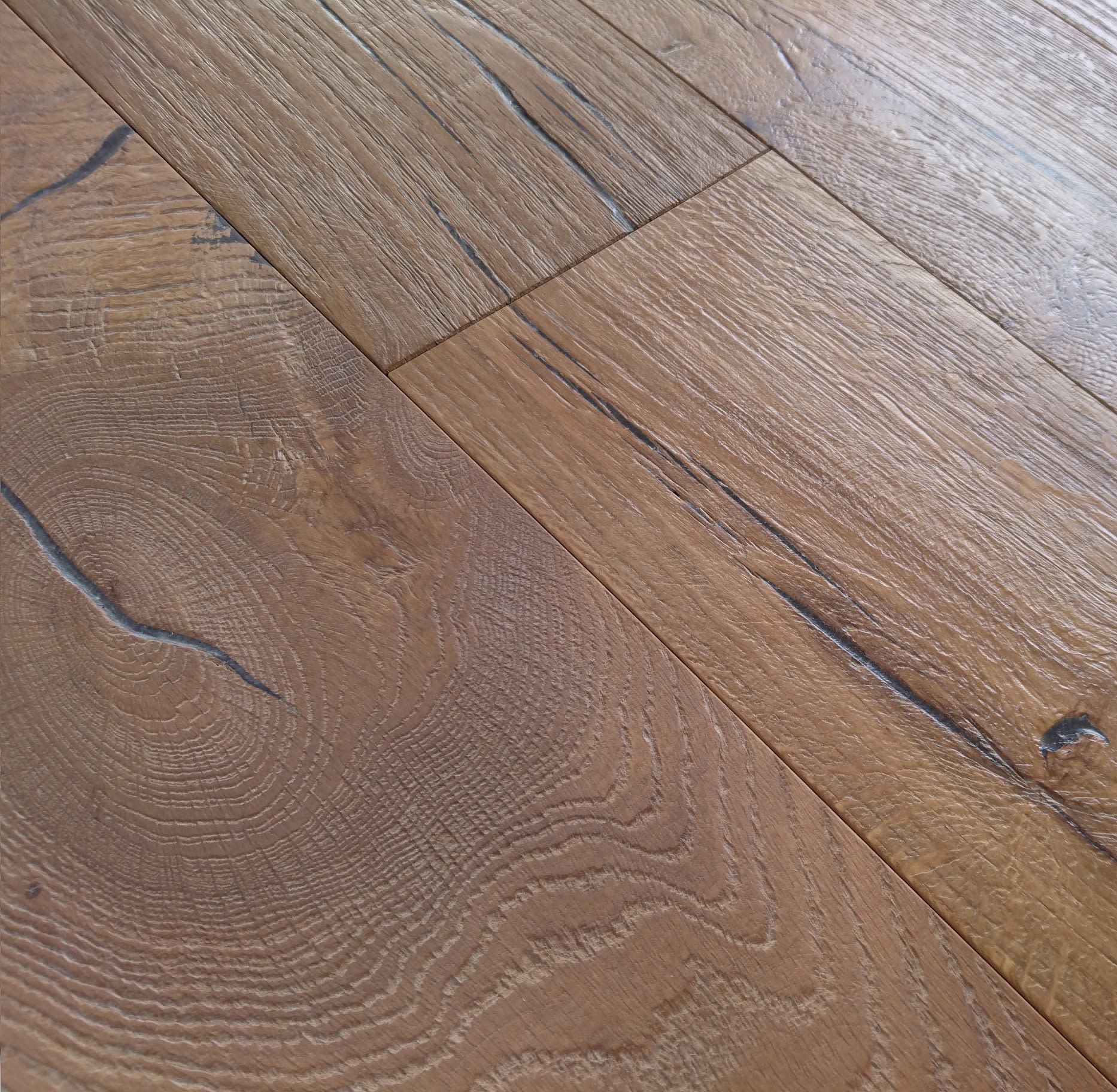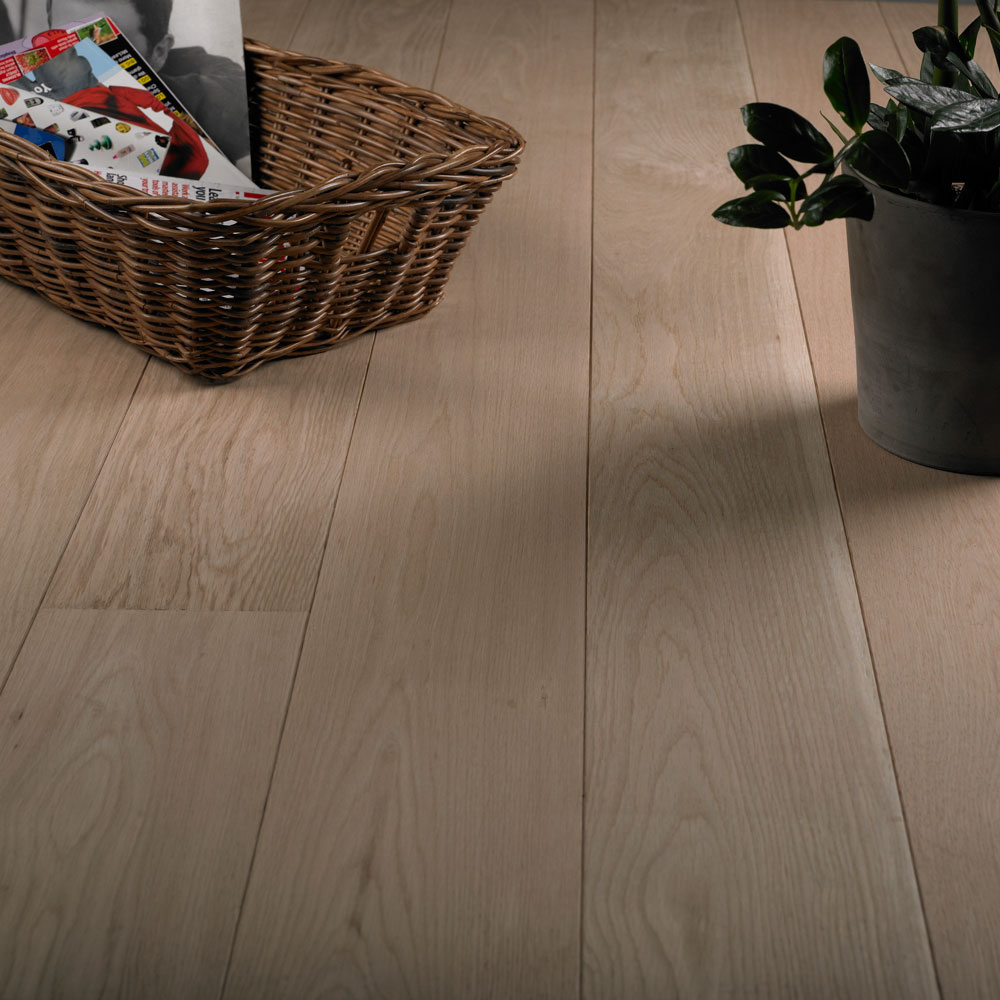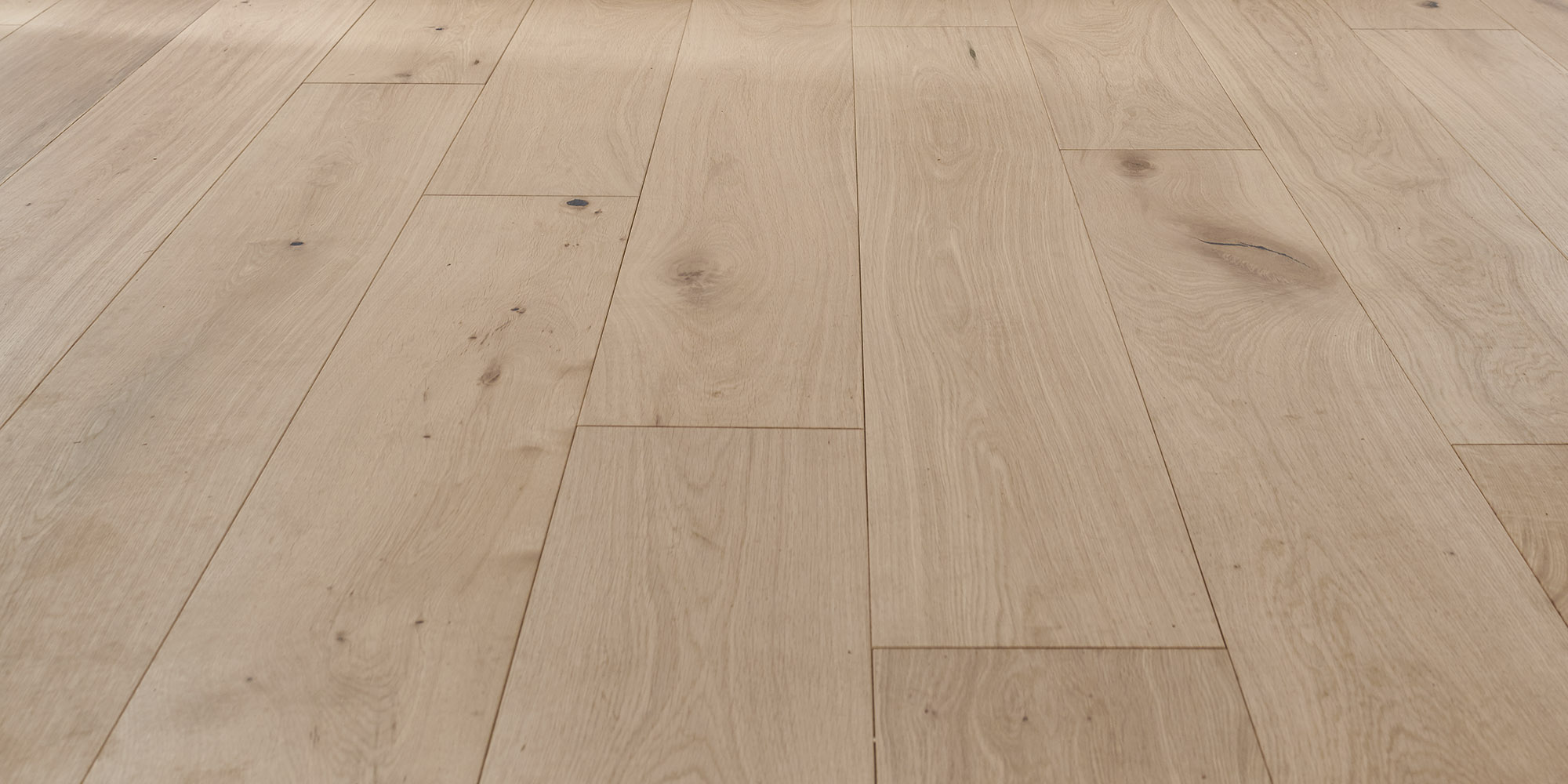Raw oak flooring offers a unique, untouched aesthetic that brings warmth and character to any living space. Embracing its natural imperfections and variations allows for a truly customized and timeless look. This natural wood provide you all those benefits and feature.
Introduction to Raw Oak Flooring

Raw oak flooring represents the purest form of wood flooring, untouched by pre-applied finishes or stains. This allows homeowners and designers complete freedom to customize the final look to perfectly match their aesthetic vision. The beauty of raw oak lies in its natural variations, including grain patterns, knots, and color nuances, making each plank unique. Choosing raw oak is an investment in both beauty and quality.
Definition of Raw Oak Flooring
Raw oak flooring, in its simplest form, is oak wood that has been milled into planks or boards suitable for flooring but has not been sanded, stained, or finished in any way by the manufacturer. It is left in its natural state, showcasing all the characteristics of the oak tree from which it was sourced. This “unfinished” state is precisely what makes it so appealing to those seeking a unique and customizable flooring solution. The term “raw” signifies the absence of any artificial treatments that would mask the wood’s natural beauty. Instead, it arrives ready to be transformed according to the homeowner’s specific preferences. Think of it as a blank canvas eagerly awaiting the artist’s touch.
The raw state of the wood allows for a greater depth of customization than pre-finished options. You’re not limited to the colors or textures offered by the manufacturer; instead, you have the freedom to choose from a wide range of stains, oils, and sealant to achieve your desired look. This also means you can adjust the finish over time, refinishing and restaining the floor to adapt to changing trends or updating your home decor. This flexibility is a significant advantage for those who want their floor to truly reflect their personal style. Selecting raw oak is about gaining full control over the final aesthetic outcome.
Furthermore, different grades of raw oak are available, each with varying degrees of knots, color variation, and grain patterns. The grade you choose will depend on the look you’re trying to achieve. For a rustic, character-filled floor, a grade with more knots and color variation might be ideal. Conversely, a cleaner, more uniform look might call for a higher grade with fewer imperfections. Raw oak flooring is not just a building material; it’s a design element that can add significant character and charm to a space.
Importance of Choosing Raw Oak
The decision to choose raw oak flooring is a significant one, influenced by a number of factors, including aesthetic preferences, lifestyle considerations, and the desire to create a unique and personalized living space. One of the primary reasons people opt for raw oak is the unrivaled level of customization it offers. Unlike pre-finished flooring, which comes with a predetermined color and finish, raw oak is a blank slate, ready to be tailored to your exact specifications. This means you can choose the perfect stain to complement your furniture, walls, and overall design scheme, resulting in a cohesive and harmonious look.
Beyond aesthetics, raw oak flooring allows for a deeper connection to the natural world. The inherent variations in the wood grain, the subtle color differences, and the presence of natural imperfections create a sense of authenticity and character that is difficult to replicate with manufactured products. This connection to nature can bring a sense of calm and tranquility to a home, creating a more inviting and comfortable living environment. This is particularly appealing in modern homes.
Moreover, raw oak flooring boasts remarkable durability and longevity. When properly installed and finished, it can withstand the wear and tear of daily life for generations. Unlike some flooring options that require frequent replacement, raw oak can be refinished multiple times, extending its lifespan and preserving its beauty for years to come. This makes it a sustainable and cost-effective choice in the long run. The combination of customization, natural beauty, and durability makes raw oak flooring an exceptional material.
Overview of Common Uses
Raw oak flooring, with its versatile nature and aesthetic appeal, finds its way into a wide range of residential and commercial spaces. In homes, it is commonly used in living rooms, dining rooms, bedrooms, and hallways, where its natural warmth and beauty can be fully appreciated. Its durability also makes it a suitable choice for high-traffic areas, providing a long-lasting and stylish flooring solution. In modern homes, raw oak floors contribute to minimalist and natural design themes due to its customizable nature and raw aesthetic.
In commercial settings, such as retail stores, restaurants, and offices, raw oak flooring can add a touch of sophistication and warmth, creating a more inviting and welcoming atmosphere for customers and employees. Its ability to withstand heavy foot traffic makes it a practical choice for these environments, and its customizable nature allows businesses to tailor the flooring to their brand identity. The type of finish can be selected according to the anticipated usage and aesthetic goals.
Furthermore, raw oak flooring is increasingly being used in unique and creative ways, such as wall cladding, ceiling panels, and even furniture design. Its natural beauty and versatility make it a sought-after material for architects and designers looking to add a touch of elegance and sophistication to their projects. The possibilities are seemingly endless, limited only by imagination. Raw oak’s popularity stems from its ability to be both functional and visually interesting.
Characteristics of Raw Oak Flooring

The attractiveness of raw oak flooring extends beyond its unfinished state, encompassing a range of distinctive attributes that appeal to various preferences. Its natural aesthetics, exceptional durability, and environmental sustainability position it as a highly desirable option for a wide variety of spaces. Exploring these features will provide a deeper appreciation for the lasting worth and significance of raw oak flooring.
Natural Aesthetics and Grain Patterns
One of the most compelling aspects of raw oak flooring is its inherent natural beauty. The wood’s grain patterns, knots, and color variations create a unique and organic aesthetic that cannot be replicated by synthetic materials. Each plank tells a story, reflecting the tree’s growth and the environment in which it thrived. These natural imperfections add character and charm to a space, creating a warm, inviting atmosphere that is both timeless and elegant. This visual appeal is hard to surpass.
The grain patterns in raw oak can vary significantly, depending on the cut of the wood. Quarter-sawn oak, for example, exhibits a tight, straight grain pattern that is highly resistant to warping and cupping, while plain-sawn oak features a more pronounced, cathedral-like grain pattern. The choice of grain pattern will depend on the desired aesthetic and the specific application. Designers and homeowners can select the grain type that best suits their needs and preferences.
The color of raw oak can range from light beige to warm brown, with subtle variations that add depth and dimension to the floor. Over time, the wood will naturally darken and mellow, developing a rich patina that enhances its beauty and character. This natural aging process contributes to the floor’s timeless appeal, creating a sense of history and authenticity that is difficult to achieve with other flooring materials. This natural aging truly sets raw oak apart.
Durability and Longevity
Raw oak flooring is renowned for its exceptional durability and longevity. Oak is a hardwood, meaning it is naturally dense and resistant to wear and tear. When properly installed and finished, raw oak flooring can withstand the rigors of daily life for decades, with minimal maintenance. This makes it a cost-effective choice in the long run, as it eliminates the need for frequent replacements or repairs. This longevity saves time and money.
The durability of raw oak flooring is further enhanced by its ability to be refinished multiple times. Over the years, the surface of the floor may become scratched or worn, but it can be easily restored to its original beauty by sanding down the old finish and applying a new one. This refinishing process can be repeated several times throughout the floor’s lifespan, extending its usability and preserving its aesthetic appeal. Refinishing provides a fresh look without the cost of replacing the entire floor.
Furthermore, oak is a relatively stable wood, meaning it is less likely to warp, crack, or expand and contract with changes in humidity and temperature. This stability is particularly important in areas with fluctuating climates, where other flooring materials may be more susceptible to damage. The resilience of oak makes it a reliable choice for a wide range of environments, ensuring a long-lasting and beautiful flooring solution. Investing in raw oak is an investment in long-term durability.
Environmental Impact and Sustainability
In today’s environmentally conscious world, the sustainability of building materials is a major consideration for many homeowners and designers. Raw oak flooring offers a number of environmental benefits, making it a responsible choice for those seeking to minimize their ecological footprint. Oak is a renewable resource, and when sourced from sustainably managed forests, it can be a truly eco-friendly flooring option.
Sustainable forest management practices ensure that trees are harvested responsibly, with replanting and conservation efforts in place to maintain the health and biodiversity of the forest ecosystem. By choosing raw oak flooring from suppliers who adhere to these practices, consumers can support sustainable forestry and contribute to the preservation of our natural resources. Supporting sustainable practices helps protect the environment for future generations.
- Sustainably managed forests ensure:
- Responsible harvesting practices
- Reforestation efforts
- Protecting biodiversity
- Minimizing environmental impact
Furthermore, raw oak flooring is a natural and biodegradable material, meaning it will decompose harmlessly at the end of its life cycle. Unlike synthetic flooring options that can release harmful chemicals into the environment, raw oak is a safe and eco-friendly choice for your home. By choosing raw oak, homeowners can reduce their reliance on synthetic materials and create a healthier and more sustainable living environment. The natural composition of oak makes it a sustainable choice for environmentally conscious homeowners.
Installation Process

Installing raw oak flooring requires careful planning, precise execution, and a thorough understanding of the materials and techniques involved. A well-executed installation is crucial for ensuring the longevity, stability, and aesthetic appeal of the finished floor. This section will outline the key steps involved in the installation process, from preparing the subfloor to selecting the appropriate installation method.
Preparing the Subfloor
The subfloor is the foundation upon which your raw oak flooring will be installed, and its condition is critical to the success of the entire project. A properly prepared subfloor should be clean, level, dry, and structurally sound. Any deficiencies in the subfloor can lead to problems with the finished floor, such as squeaking, warping, or unevenness. Taking the time to properly prepare the subfloor is essential for ensuring a successful and long-lasting installation.
The first step in preparing the subfloor is to thoroughly clean it, removing any dust, debris, or old adhesives. A vacuum cleaner or broom can be used to remove loose particles, and a scraper can be used to remove any stubborn residue. A clean subfloor will ensure proper adhesion of the flooring material. After cleaning, it is important to check the subfloor for levelness. High spots can be sanded down, and low spots can be filled with a leveling compound.
Next, the moisture content of the subfloor should be checked using a moisture meter. Excess moisture can cause the wood flooring to warp or buckle, so it is important to ensure that the subfloor is within the acceptable moisture range. If the moisture content is too high, steps should be taken to dry out the subfloor before proceeding with the installation. Addressing moisture issues is crucial for preventing future problems with the flooring.
Types of Installation Methods
There are several different methods for installing raw oak flooring, each with its own advantages and disadvantages. The most common methods include nail-down, glue-down, and floating. The choice of installation method will depend on the type of subfloor, the width and thickness of the flooring planks, and the homeowner’s personal preferences. Understanding the different installation methods is essential for choosing the best approach for your specific project.
The nail-down method involves attaching the flooring planks directly to the subfloor using nails or staples. This method is typically used over wood subfloors and is best suited for solid hardwood flooring. It provides a secure and stable installation, but it can be more time-consuming and labor-intensive than other methods. Nailing provides a strong and traditional attachment method.
The glue-down method involves adhering the flooring planks to the subfloor using a special adhesive. This method can be used over a variety of subfloors, including concrete and wood, and is suitable for both solid and engineered hardwood flooring. It provides a very stable and durable installation, but it can be more expensive than other methods due to the cost of the adhesive. Gluing creates a solid connection between the flooring and the subfloor.
The floating method involves installing the flooring planks over a thin foam underlayment, without attaching them directly to the subfloor. This method is typically used for engineered hardwood flooring and is the easiest and fastest installation method. However, it may not provide the same level of stability and durability as the nail-down or glue-down methods. Floating floors are often chosen for their ease of installation.
Tools and Materials Needed
Installing raw oak flooring requires a variety of tools and materials, including:
- A moisture meter
- A level
- A saw (circular saw, miter saw, or hand saw)
- A nail gun or staple gun (for nail-down installations)
- Adhesive (for glue-down installation)
- A trowel (for spreading adhesive)
- A rubber mallet
- Spacers
- Safety glasses
- Dust mask
Having all the necessary tools and materials on hand before starting the installation process will help ensure a smooth and efficient project. Gather all tools before beginning the project.
Common Mistakes to Avoid
Installing raw oak flooring can be a challenging project, and it is important to avoid common mistakes that can compromise the quality and longevity of the finished floor. One of the most common mistakes is failing to properly prepare the subfloor. As mentioned earlier, a clean, level, dry, and structurally sound subfloor is essential for a successful installation. Failing to address any deficiencies in the subfloor can lead to problems with the finished floor. Proper subfloor preparation is the foundation of a successful installation.
Another common mistake is using the wrong type of adhesive or fasteners. It is important to use adhesives and fasteners that are specifically designed for wood flooring and that are compatible with the type of subfloor you are using. Using the wrong materials can lead to adhesion failures or damage to the flooring. Selecting the correct materials is crucial for a durable installation.
Another mistake is neglect proper expansion gaps around the perimeter of the room and around any fixed objects, such as pipes or columns. Wood flooring expands and contracts with changes in humidity and temperature, and leaving adequate expansion gaps will allow the floor to move freely without buckling or warping. Expansion gaps prevent the floor from buckling.
Maintenance and Care
Proper maintenance and care are essential for preserving the beauty and extending the lifespan of your raw oak flooring. Regular cleaning, appropriate finishing options, and preventative measures can help protect your floor from damage and keep it looking its best for years to come. This section will provide practical tips and strategies for maintaining and caring for your raw oak flooring.
Cleaning Techniques for Raw Oak
Cleaning raw oak flooring requires a gentle touch and the use of appropriate cleaning products. Harsh chemicals and abrasive cleaners can damage the finish and dull the natural beauty of the wood. Regular sweeping or vacuuming is the best way to remove dirt and debris from the floor. Occasional damp mopping with a mild soap solution can help remove stubborn stains and grime.
When damp mopping, it is important to use a well-wrung-out mop to avoid saturating the floor with water. Excess water can seep into the wood and cause it to warp or buckle. A microfiber mop is a good choice for cleaning raw oak flooring, as it is gentle on the finish and effectively removes dirt and debris. Microfiber mops are effective and gentle on wood floors.
Avoid using steam cleaners on raw oak flooring, as the high heat and moisture can damage the finish. Also, avoid using waxes or polishes that can dull the finish and make the floor slippery. Maintaining a clean and dry floor is the best way to prevent damage and extend its lifespan. Regular cleaning is a simple yet effective way to care for a raw oak floor.
Finishing Options and Their Benefits
Choosing the right finish for your raw oak flooring is crucial for protecting the wood and enhancing its natural beauty. There are a variety of finishing options available, each with its unique properties and benefits. The most common finishing options include:
- Penetrating oil finishes
- Surface finishes (polyurethane, varnish)
- Wax finishes
Penetrating oil finishes, such as tung oil or linseed oil, soak into the wood pores and harden, creating a durable and water-resistant surface. These finishes enhance the natural grain and color of the wood and are easy to repair and maintain. Penetrating oils create a natural look and are easy to repair.
Surface finishes, such as polyurethane or varnish, form a protective layer on top of the wood. These finishes are highly resistant to scratches, stains, and water damage, but they can be more difficult to repair than penetrating oil finishes. Polyurethane finishes provide a durable and protective layer.
Wax finishes provide a soft, low-luster sheen and can be easily buffed to restore their shine. However, wax finishes are not as durable as other options and require more frequent maintenance. Wax finishes offer a traditional look but require regular upkeep.
Strategies for Preventing Damage
Preventing damage is the best way to keep your raw oak flooring looking its best. Simple strategies, such as using area rugs in high-traffic areas, placing mats at entrances, and lifting furniture instead of dragging it, can help protect the floor from scratches, dents, and stains. Protecting the floor prevents unnecessary wear and tear.
Avoid wearing shoes with cleats or high heels on the floor, as these can cause dents and scratches. Also, be careful when moving heavy objects, such as appliances or furniture, to avoid damaging the floor. Protecting the floor from heavy impacts is important for preventing dents.
Clean up spills immediately to prevent staining. Certain liquids, such as red wine or juice, can permanently stain the wood if left unattended. Promptly cleaning up spills prevents staining and damage.
Seasonal Care Tips
Raw oak flooring can be affected by changes in humidity and temperature, so it is important to adjust your care routine according to the season. In the winter, when the air is dry, the wood can shrink and crack. Using a humidifier can help maintain a consistent humidity level and prevent the floor from drying out. Maintaining humidity levels is important in dry climates.
In the summer, when the air is humid, the wood can expand and buckle. Using an air conditioner can help reduce humidity and prevent the floor from warping. Also, avoid leaving windows open during humid weather. Controlling humidity is crucial for preventing warping.
Regularly inspect your raw oak flooring for signs of damage, such as cracks, warping, or discoloration. Addressing any problems promptly can prevent them from becoming more serious and costly to repair. Regular inspections help identify and address issues early on.
Comparisons with Other Flooring Options
Choosing the right flooring material for your home or business is a significant decision, influenced by several factors such as aesthetics, budget, durability, and maintenance requirements. Raw oak flooring stands as a distinct option with its inherent charm and versatility, but it is crucial to assess it against other popular choices like engineered wood and laminate flooring. This comparison will provide a thorough perspective on the strengths and weaknesses of raw oak flooring in relation to these alternatives, facilitating a well informed decision that aligns with your unique requirements.
Raw Oak vs. Engineered Wood
Engineered wood flooring is often mistaken for solid hardwood flooring, but there are key differences between the two. Engineered wood consists of a thin layer of hardwood veneer glued to a plywood or fiberboard core. This construction makes it more resistant to moisture and warping than solid hardwood, making it a good choice for areas with fluctuating humidity levels. Engineered wood is more stable in humid environments.
However, engineered wood flooring typically has a shorter lifespan than raw oak flooring, as the thin veneer can only be refinished a limited number of times. Raw oak flooring, on the other hand, can be refinished multiple times, extending its lifespan and preserving its beauty for years to come. Raw oak offers greater longevity.
Also, the aesthetic appeal of raw oak flooring is often considered to be superior to that of engineered wood. The natural variations in the wood grain, the subtle color differences, and the presence of natural imperfections create a sense of authenticity and character that is difficult to replicate with engineered wood. Raw oak has a more authentic look and feel.
Raw Oak vs. Laminate Flooring
Laminate flooring is a synthetic product made from layers of compressed fiberboard topped with a photographic image of wood grain. It is a budget-friendly option that is easy to install and maintain. Laminate is a cost-effective and easy-to-install option.
However, laminate flooring lacks the natural beauty and warmth of raw oak flooring. The photographic image can look artificial, and the surface is often cold and hard to the touch. Raw oak has a natural warmth and beauty.
Also, laminate flooring is not as durable as raw oak flooring and is more susceptible to scratches, dents, and water damage. It cannot be refinished, so once it is damaged, it must be replaced. Raw oak is more durable and can be refinished.
Cost Comparison
The cost of raw oak flooring can vary depending on the species of oak, the grade of the wood, and the width and thickness of the planks. Generally, raw oak flooring is more expensive than engineered wood and laminate flooring. Raw oak typically has a higher upfront cost.
However, the long-term cost of raw oak flooring may be lower than that of other options, due to its durability and ability to be refinished. Raw oak can last for generations with proper care, while engineered wood and laminate flooring may need to be replaced multiple times over the same period. Raw oak offers long-term value.
Also, the added value and aesthetic appeal of raw oak flooring can increase the overall value of your home, making it a worthwhile investment for those seeking to add lasting beauty and character to their living space. Raw oak can increase a home’s value.
Video
Video source from Youtube
Conclusion
In summary, raw oak flooring stands out as a premier choice for homeowners and designers alike, owing to its unique blend of natural beauty, remarkable durability, and environmental sustainability. Its outstanding characteristic lies in the degree of personalization it provides, enabling the achievement of a distinctive and customized aesthetic that seamlessly enhances any area. While it may entail a greater initial financial commitment compared to alternatives such as engineered wood or laminate flooring, the extended lifespan and enduring allure of raw oak render it a worthwhile and eco-conscious solution for those wanting to infuse their spaces with timeless class and character.
Read also : Embrace Timeless Elegance – Wide Board Oak Flooring Guide
